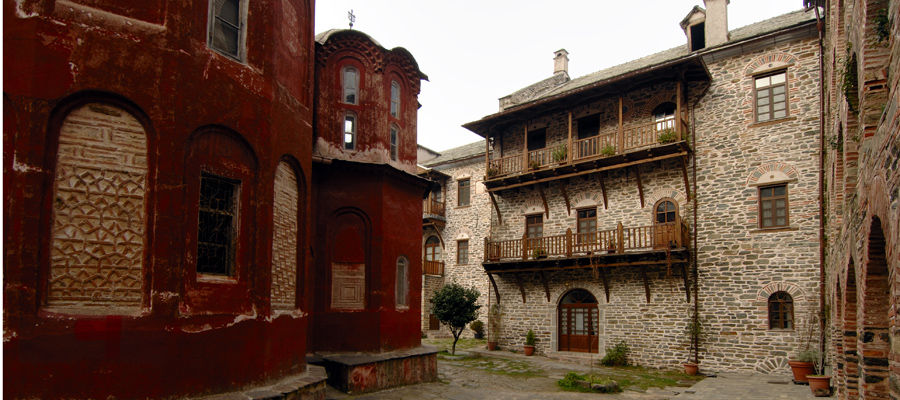Koutloumousiou monastery
It is located very close to Karyes. Despite the fact that a forged manuscript states its founder was Alexios A’ Komnenos, a first written testimony signed by the abbot refers to its existence in 1169.
The monastery had the same fate as the other monasteries in Mount Athos. It was pillaged by Catalan pirates in the 14th century and suffered the consequences of catastrophic fires in 1859 and 1870.
Legend says that it was named after its founder Constantine, son of Seljuk prince Azzedin Koutloumous, who was baptized Christian and retired to Athos. The poor and small monastery received 40 monks until the 14th century and acquired important properties in Serres, Halkidiki and Wallachia. It reached its prime days during the time when Chariton was an abbot (1362-1381), who attracted the protection of Wallachia’s rulers. It had also been given generous donations by Andronikos II Palaiologos and Theodora Kantakouzene. According to history, in 1371, abbot Chariton was forced to allow the peculiar solitary exercise system that lasted until 1856, as a courtesy to the monks that came from Wallachia.
The year 1428 was a milestone in the history of Koutloumousiou, when the monks received the abandoned monastery of Alypius. Then the two monasteries united under one abbot. The Catholicon is one of the smallest in Athos and honors the Transfiguration of Christ and must have been built during the time of abbot Chariton. It has murals of Cretan school dated in 1549 and an ornate, gold plated, wood carved “iconostasio” (icon‐screen) of the 19th century. The monastery has 13 chapels in total and the Skete of St. Panteleimon (1785) depends on it. The famous Athoniada School that operated until 1930, was established in 1842 at the Koutloumousian Cell of John the Baptist.
According to tradition a valuable stock of the monks are the sacred relics gifted by Alexios Komnenos: The indestructible foot of Theomitoros Anna, the hand of St. Gregory the Theologian, the skull of St. Alypius, a piece of the Holy Cross, etc. The sixth in hierarchy and twelveth oldest monastery, treasures in its library 750 manuscript codes and 5.000 books.
Text: Dr. Antonios G. Dikaios/ Theologian – Environmentalist.






